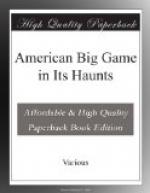[Footnote 9: Addendum.—There is no question as to the good intention of State legislation. The chief difficulty in the enforcement of the law is that officers appointed locally, and partly from political reasons, shrink from applying the penalties of the law to their own friends and neighbors, especially where the animals are apparently abundant and are sought for food. The honest enforcement of the law renders the officer unpopular, even if it does not expose him to personal danger. He is regarded as interfering with long established rights and customs. The above applies to conscientious officers. Many local game wardens, as in the Colorado White River Plateau, for example, give absolutely no attention to their duties, and are not even on the ground at the opening of the season. In the Plateau in August, 1901, the laws were being openly and flagrantly violated, not only by visitors, but by residents. At the same time the National forest laws were being most strictly and intelligently enforced. There is no question whatever that the people of various States can be brought to understand that National aid or co-operation in the protection of certain wild areas is as advantageous to a locality as National irrigation and National forest protection. It is to be sought as a boon and not as an infringement.]
THE VARIOUS CAUSES OF ELIMINATION.
The enemies of our wild animals are numerous and constantly increasing. (1) There is first the general advance of what we call civilization, the fencing up of country which principally cuts off the winter feeding grounds. This was especially seen in the country south of the National Park last winter. (2) The destruction of natural browsing areas by cattle and sheep, and by fire. (3) The destruction of game by sportsmen plays a comparatively small part in the total process of elimination, yet in some cases it is very reckless, and especially bad in its example. When I first rode into the best shooting country of Colorado in 1901, there was a veritable cannonading going on, which reminded me of the accounts of the battle of El Caney. The destruction effected by one party in three days was tremendous. In riding over the ground—for I was not myself shooting—I was constantly coming across the carcasses of deer. (4) The summer and winter killing for food; this is the principal and in a sense the most natural and legitimate cause, although it is largely illegal. In this same area, which was more or less characteristic and typical of the other areas, even of the conditions surrounding the national reserve in the Big Horn region, the destruction was, and is, going on principally during the winter when the deer are seeking the winter ranges and when they are actually shot and carted away in large numbers for food both for the ranchmen and for neighboring towns. Making all allowances for exaggeration, I believe it to be absolutely true that these deer were being killed by the wagonload! The same is true of the pronghorn antelope in the Laramie Plains district. The most forceful argument against this form of destruction is that it is extremely short-lived and benefits comparatively few people. This argument is now enforced by law and by public sentiment in Maine and New York, where the wild animals, both deer and moose, are actually increasing in number.




